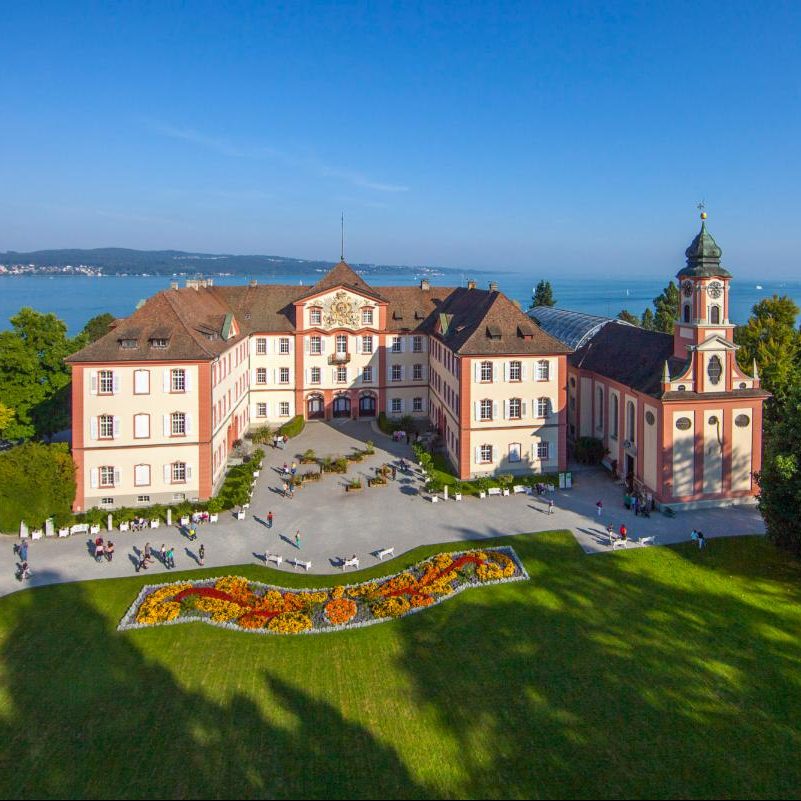The State Tourist Board of Baden-Württemberg, also known as SouthWest Germany, is home to one of the most beautiful and relaxing outdoor paradises in all of Europe: Lake Constance and its island jewels. Centrally located in the heart of Europe between SouthWest Germany, Austria and Switzerland, Lake Constance offers outdoor beauty, gardens, palaces and unique museums, including a bronze age village, the Zeppelin Museum and lakeside castles. Autumn is one of the most beautiful times of year to pedal around this special corner of Europe.
Lake Constance and its exquisite islands of Mainau and Reichenau offer visitors a safe, luxurious and outdoor destination that combines history, natural beauty, water sports, medieval villages, unique museums and luxurious hotels with Michelin menus that will appeal to the current travelers seeking a beautiful escape. Biking around Lake Constance and visiting the islands by boat is one of the most memorable ways to immerse one’s self in the environment. Visitors can start by bicycle from the city of Constance and make their way to the botanical island of Mainau and then take in the Bronze Age Village, the medieval town of Meersburg followed by the Zepplin Museum in Friedrichshafen.
Botanical Garden Island of Mainau
On the garden island of Mainau, visitors are not only treated to flowers, botanicals and beautiful trees but with exhibits that teach conservation, ecology and the influence of nature. For example, during a tour of the flower island, the island guests learn about photosynthesis in the energy pavilion and generating energy. The main events however are the flowers themselves and they do not disappoint. Year after year, millions of crocuses, tulips, daffodils and hyacinths line the Frühlingallee, peonies from China and Tibet are followed by rhododendrons and azaleas. One of the highlights in the floral year is the month of June when the roses present themselves in more than 1,000 varieties along the allee. The dahlia show has a tradition on the Mainau, which announces a colorful autumn along the banks of the island. More than 12,000 dahlias with 250 varieties unfold, and each year, they choose a dahlia queen.
The Monastery Island of Reichenau
The monastery island of Reichenau is a UNESCO world heritage site and an example of the religious and cultural role of a large Benedictine monastery in the Middle Ages. The three Romanesque churches of the island from the 9th to the 11th century illustrate the early medieval architecture in Central Europe. But it’s not just the architecture, although the buildings are a stunning combination of styles from the Carolingian, Ottoman and Salian periods. The monastery and churches open up a vital historical view into the work and production of the monks and the spread of Christianity in the western world. These monks and monastery had a powerful and lasting influence on the spiritual, intellectual and artistic life in Europe. At the time, the monastery was an important artistic center and today, the wall paintings and illuminations are significant to the art history in Europe of the 10th and 11th centuries.
The Bronze Age Village on the shores of Lake Constance
Just across the lake on the opposite shore is another UNESCO World Heritage site, the Pfahlbauten or prehistoric lake dwellings from the Late Neolithic, the Bronze Age and the Early Iron Age. In 2011, 111 places with pile dwellings in six European countries became UNESCO World Heritage Sites, including nine on Lake Constance. The museum and the village, which is a network of thatched huts built on pilings (said to be for transportation or security), provide re-enactments of the lives of the pile dwellers, including a show of their tools, such as the oldest wheel and textiles in Europe, which date from around 3000 BC. The museum shows the results of the excavations from 3,000 to 900 BC. It was the preservation of archaeological finds in the mud that enabled this unique reconstruction for early life at the lake. They provide fantastic tours in English for all ages.
Medieval Town of Meersburg – the last stop on the Baden Wine Trail
Meersburg is a must visit as it is so charming and picturesque. The town owes its baroque silhouette to the prince bishops of Constance who built sumptuous castles with the participation of the famous baroque architect Balthasar Neumann. Visitors are enamored with the charming wood framework houses, alleyways and cobblestone streets, marvelous squares and panoramic views especially from the terrace of the New Castle where you can enjoy the lake and the background of the Swiss Alps.
The Zeppelin Museum in Friedrichshafen
The Zeppelin Museum brings to life innovations in technology and art. It owes its name to the airships developed by Graf Zeppelin in Friedrichshafen. It houses two collections. The first is the world’s largest collection on airships and the innovation of “lighter than air.” The highlight of this section is the walk-in, partial reconstruction of LZ 129 Hindenburg. The museum is also gradually expanding the collection to include technically innovative products originating in Friedrichshafen that have gained worldwide significance.The art collection includes works of innovative workshops from the Middle Ages and the Baroque period. During the Third Reich, Lake Constance became a refuge for leading avant-garde artists such as Otto Dix, Max Ackermann, Erich Heckel and Willi Baumeister. These artists form another focal point of the art collection.
The City of Constance
The best place to start and end your journey is the city of Constance where you can rent your bicycles and enjoy the charming town, boutique shopping and indulge in a bit of luxury at the beautiful four and five star hotels that dot the shoreline. SouthWest Germany, officially the federal state of Baden-Württemberg, is a beautiful part of Germany that has depth and breadth of history and beauty that is inspiring and instructive. Combined with world class food and wine, beautiful countryside and charming inns and hotels, SouthWest Germany is a true vacation destination. #dreamnowvisitlater






